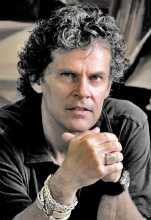 The American artist Terry Rodgers, best known for his large-scale canvases that focus on portraying contemporary body politics, was born in Newark, New Jersey and raised in Washington DC, He graduated from Amherst College in Massachusetts in 1969 with a major in Fine Arts. His photo-realistic paintings show an imaginary leisure life, exploring the tensions and confusions endemic to modern society. His images are not snapshots or slices of ‘real’ life, rather a compression and dissection of our rampant imaginations and mediated influences. The seductive and marvellous glamour of the outer world jars with the vulnerability and delicacy of the subjects’ – and our own – inner and private selves.
The American artist Terry Rodgers, best known for his large-scale canvases that focus on portraying contemporary body politics, was born in Newark, New Jersey and raised in Washington DC, He graduated from Amherst College in Massachusetts in 1969 with a major in Fine Arts. His photo-realistic paintings show an imaginary leisure life, exploring the tensions and confusions endemic to modern society. His images are not snapshots or slices of ‘real’ life, rather a compression and dissection of our rampant imaginations and mediated influences. The seductive and marvellous glamour of the outer world jars with the vulnerability and delicacy of the subjects’ – and our own – inner and private selves.

His earlier paintings often contemplated personal and family relationships in brightly-lit outdoor settings wrought with pale, intense, high-keyed colours, but most of his recent paintings conjure up a vision of the private nightlife of America’s privileged youth. Rodgers’ complex compositions emphasise the detachment of his characters: the eye can trace the angles and curves of their intersecting bodies on the painting’s surface, but their gazes almost all diverge from each other. There is a troubled insouciance in his characters living out a common fantasy – despite the clothes, the looks, the drinks, lounging in the midst of a quasi-orgy, there is something fragile and complex about his characters. The viewer is at the same time a voyeur and a guest at the party.
In November 2018 exhibition curator Raffaele Quattrone interviewed Rodgers; you can read the whole interview here; we have selected part of it.
Your works are a celebration of excess: on the one hand your artistic excess with your extraordinary virtuosity, on the other hand the one depicted in your works. What do you mean by excess?
I prefer to think in terms of complexity. These paintings are a compression of experiences, uncertainties, influences, commercial imagery, gestures, desires and vectors representing the complexity of interactions. Excess often suggests doing something in excess, an action judged negatively. I want to suggest that we are surrounded by an excess or superabundance of influences, and are perhaps isolated or lonely in the midst of this very complicated world. Every generation invents its own fantasy culture.

One of the main themes of your research is the disconnection between body and mind in a world that thanks to social networks is increasingly connected. In your artistic practice, what does disconnection mean?
For me, disconnection suggests that there is actually a desire for connection, a search for relating. And the disconnect is the failure to find a satisfying relatedness. There are many ways that we seem available to each other – parties, social media, dating sites – but it never seems easy. And I expect that it has always been like this. I don’t see it just as the result of the way the world is today. People endured failed marriages for centuries. Today many end in divorce. Both are a measure of the difficulty.
Your paintings are in most cases large and decidedly cinematic. Is there a bit of this exhibitionism in your works?
The paintings display a tension between a myriad of desires, suggestions and pressures. I suspect that the threat of social anonymity has been with us from time immemorial. To be ostracised from your tribe or clan was the kiss of death. Inclusion is a type of self-affirmation. No longer living in tiny rural communities, finding our tribe and staying included in it is way more complicated. And self-expression is always a threat to inclusion or community. So the exhibitionism we see is just an expression of need.
How do you create your works?
I spend a lot of time photographing models who I think might be able to express some aspect of an inner life. I work with them individually, and then later I start to play with how some images can work with others to reveal some of the energy currents in our world.
We would like to thank our Russian friend and contributor Yuri for introducing us to the work of this artist and supplying many of the images.





























































